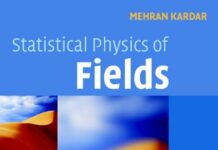
Ebook Info
- Published: 2007
- Number of pages: 330 pages
- Format: PDF
- File Size: 2.70 MB
- Authors: Mehran Kardar
Description
Statistical physics has its origins in attempts to describe the thermal properties of matter in terms of its constituent particles, and has played a fundamental role in the development of quantum mechanics. Based on lectures taught by Professor Kardar at MIT, this textbook introduces the central concepts and tools of statistical physics. It contains a chapter on probability and related issues such as the central limit theorem and information theory, and covers interacting particles, with an extensive description of the van der Waals equation and its derivation by mean field approximation. It also contains an integrated set of problems, with solutions to selected problems at the end of the book and a complete set of solutions is available to lecturers on a password protected website at www.cambridge.org/9780521873420. A companion volume, Statistical Physics of Fields, discusses non-mean field aspects of scaling and critical phenomena, through the perspective of renormalization group.
User’s Reviews
Reviews from Amazon users which were colected at the time this book was published on the website:
⭐Book arrived in good shape as expected. Happy with purchase. As for the book itself, I got it for a class. It has worked great, but I purchased out of necessity.
⭐This book is extremely careful in its derivations, which makes line by line careful study very helpful. I really like this. Furthermore, it’s able to to cover a very large amount of material in very few pages by being as direct as possible… this might seem mathematical to some, but I think it’s great because the math is very clear. Ideally, for a first course, I prefer a systematic approach, leaving the intuitive stuff only when it’s justified. Beware, however, the problems are very hard, and often require very good command of the material.
⭐Ive always felt that a post-pathria/huang/etc. stat mech book was needed to do a good job on landau theory and perturbation theory for phase transitions…whatever one might call ‘statistical field theory.’ I found Kardar’s lectures (turned into this book) to be exquisitely clear, and everything i’d ever hoped for in the realm of phase transition pedagogy. He has included material beyond the standard m^4 magnetic transition, like the nonlinear sigma model, BKT transition, and random walks. I cannot endorse this book highly enough, and expect it’ll become sort of the ‘jackson’ of stat mech 2.
⭐Amazing book. The lectures (available on the youtube channel for MIT OCW) are also amazing and pair well with reading the book.
⭐Ok, this book will make you work for everything, no free stuff here. Chapters give you only basic information, and you have to work out exercises in the end of the chapter to get the details.
⭐Good book.
⭐Kardar’s book is exceptionally good at illustrating the mathematical structure of renormalization and field theory. If you like your physics as rigorous and clean as possible, this is a good book. Of course, it would be easier to read if you have background in QFT, but that’s not necessarily a pre-req.Downsides:1. Sometimes Kardar skips the proofs of nontrivial assertions (at least they were nontrivial to me). For example, why does the RG preserve the partition function? Kardar gives a half-sentence outline, but I think it deserves better.2. There are very few worked-out examples in the book, which explains why the exposition portion of the book is only around 200 pages.Both issues can easily be resolved by consulting other sources, so this is fine as a main text. Sometimes, watching Kardar’s lectures on OCW can help clear up what he left out in the book. A pleasure to read!
⭐The book is certainly a good book to learn statistical field theory from, but the starry reviews by L. Balents, D. Chandler, E. Stanley, and other NSF fellow travelers are way, way too hyped. No, this book does not compare to Landau’s books in any form (or contents, for that matters), and no, you will not be led from the student stage to the expert stage by reading this book alone. The book is just another good graduate level textbook; actually, part of the material can be grasped by a motivated senior undergraduate student interested in stat. mech. (and this is a merit of the good pedagogy included in the presentation of the material).If you want to delve into statistical field theory, I recommend
⭐, by K. Huang (at an introductory level similar to that of this book),
⭐, by G. Mussardo (at an intermediate level, dealing with complementary subjects), and the monograph
⭐by G. Parisi (more advanced, a little bit dated).
⭐This book is excellent material wise, and the print is very good as well.
⭐Neither very rigorous nor very intuitive.. Not recommended.. Use R Pathria or Goldenfled..
⭐good
⭐I do not know any better book in this field for beginners than this one. I particularly liked the fact that Kardar has included certain things in his book that are not found elsewhere.
Keywords
Free Download Statistical Physics of Particles 1st Edition in PDF format
Statistical Physics of Particles 1st Edition PDF Free Download
Download Statistical Physics of Particles 1st Edition 2007 PDF Free
Statistical Physics of Particles 1st Edition 2007 PDF Free Download
Download Statistical Physics of Particles 1st Edition PDF
Free Download Ebook Statistical Physics of Particles 1st Edition
